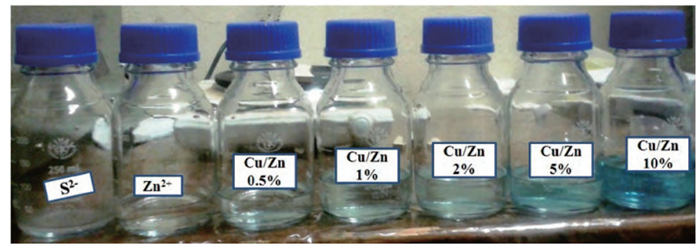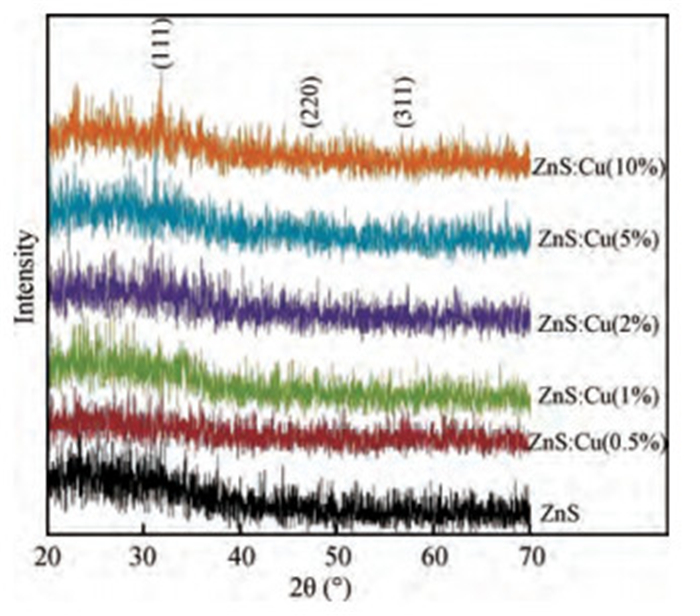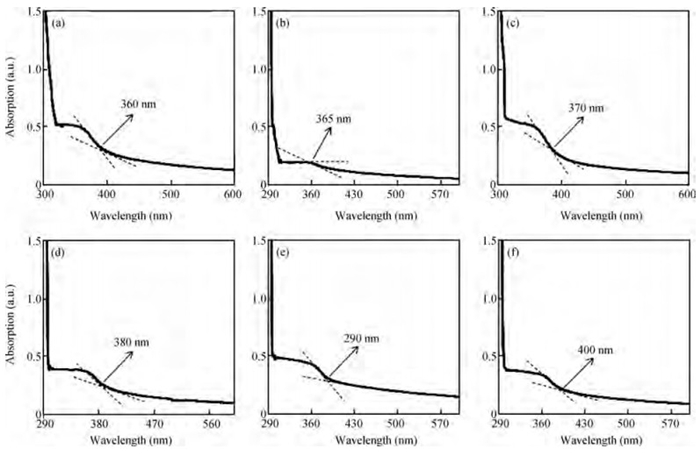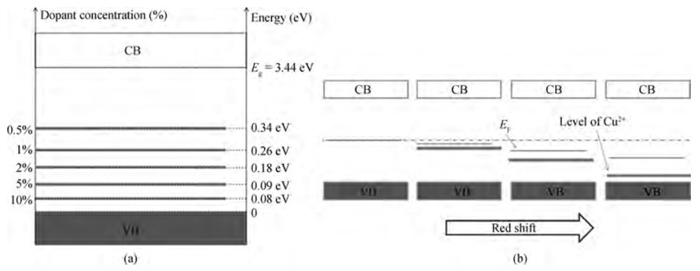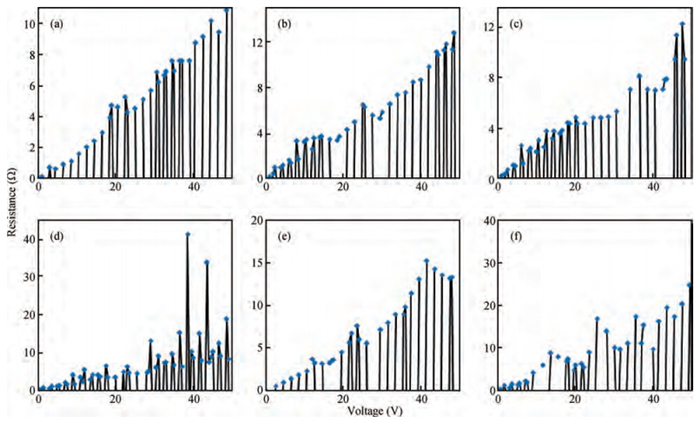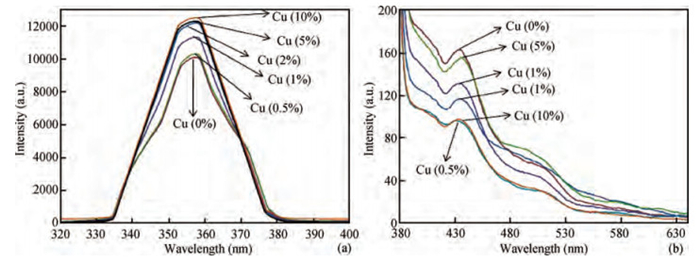| Citation: |
M. Mehrabian, Z. Esteki, H. Shokrvash, G. Kavei. Optical and electrical properties of copper-incorporated ZnS films applicable as solar cell absorbers[J]. Journal of Semiconductors, 2016, 37(10): 103002. doi: 10.1088/1674-4926/37/10/103002
****
M. Mehrabian, Z. Esteki, H. Shokrvash, G. Kavei. Optical and electrical properties of copper-incorporated ZnS films applicable as solar cell absorbers[J]. J. Semicond., 2016, 37(10): 103002. doi: 10.1088/1674-4926/37/10/103002.
|
Optical and electrical properties of copper-incorporated ZnS films applicable as solar cell absorbers
DOI: 10.1088/1674-4926/37/10/103002
More Information
-
Abstract
Un-doped and Cu-doped ZnS (ZnS:Cu) thin films were synthesized by Successive Ion Layer Absorption and Reaction (SILAR) method. The UV-visible absorption studies have been used to calculate the band gap values of the fabricated ZnS:Cu thin films. It was observed that by increasing the concentration of Cu2+ ions, the Fermi level moves toward the edge of the valence band of ZnS. Photoluminescence spectra of un-doped and Cu-doped ZnS thin films was recorded under 355 nm. The emission spectrum of samples has a blue emission band at 436 nm. The peak positions of the luminescence showed a red shift as the Cu2+ ion concentration was increased, which indicates that the acceptor level (of Cu2+) is getting close to the valence band of ZnS.-
Keywords:
- ZnS,
- Cu2+ doped ZnS,
- UV-visible absorption,
- photoluminescence
-
References
[1] Jindal Z, Verma N K. Effect of UV radiation on the photoluminescent properties of Cu-doped ZnS nanoparticles. Optoelectronics and Advanced Materials- Rapid Communications, 2008, 2(3): 166[2] Wanjari L, Bisen D P, Brahme N, et al. Thermoluminescence characteristics of ZnS:Cu nanoposphors. J Optoelectron Biomed Mater, 2015, 7(3): 59 http://www.chalcogen.ro/59_Wanjari.pdf[3] Linares P G, Marti A, Antolın E, et al. Voltage recovery in intermediate band solar cells. Solar Energy Materials & Solar Cells, 2012, 98: 240 http://cn.bing.com/academic/profile?id=2146240641&encoded=0&v=paper_preview&mkt=zh-cn[4] Puksec J D. Recombination processes and holes and electrons lifetimes. Automatika, 2002, 43: 1[5] Chen Jinhuo, Li Wenjian. Significant improvement of ZnS film electrical and optical performance by indium incorporation. Journal of Semiconductors, 2014, 35(9): 093003 doi: 10.1088/1674-4926/35/9/093003[6] Prabu H J, Johnson I, Greener C. Chemical synthesis and characterization of Mg doped ZnS nanoparticles and their engineering band gap performance. J Engineering Research and Applications, 2015, 5(8): 99 http://www.ijera.com/papers/Vol5_issue8/Part%20-%204/M580499105.pdf[7] Srivastava R K, Pandey N, Mishra S. Effect of Cu concentration on the photoconductivity properties of ZnS nanoparticles synthesized by co-precipitation method. Materials Science in Semiconductor Processing, 2013, 16: 1659 doi: 10.1016/j.mssp.2013.06.009[8] Joseph B, Manoj P K, Vaidyah V K. Studies on the structural, electrical and optical properties of Al-doped ZnO thin films prepared by chemical spray deposition. J Ceramics International, 2006, 32(5): 487 doi: 10.1016/j.ceramint.2005.03.029[9] Hasanzadeh J, Taherkhani A, Ghorbani M. Luminescence and structural properties of ZnS:Cu nanocrystals prepared using a wet chemical technique. Chinese Journal of Physics, 2013, 51(3): 540 http://cn.bing.com/academic/profile?id=2185201046&encoded=0&v=paper_preview&mkt=zh-cn[10] Long B, Cheng S, Zhou H, et al. The optical and electrical characteristics of ZnS:In thin films prepared by chemical bath deposition method. ECS Solid State Lett, 2014, 3(11): 140 doi: 10.1149/2.0041411ssl[11] Yamamoto T. Co-doping method for solutions of doping problems in wide-band-gap semiconductors. Phys Stat Sol A, 2002, 193(3): 423 doi: 10.1002/(ISSN)1521-396X[12] Li Wenjian, Chen Jinhuo, Chen Shuying. Substrate temperature effects on the structural and photoelectric properties of ZnS:In films. Journal of Semiconductors, 2014, 35(2): 023001 doi: 10.1088/1674-4926/35/2/023001[13] Bol A A, Ferwerda J, Bergwerf J A, et al. Luminescence of nanocrystalline ZnS:Cu2+. J Lumin, 2002, 99: 325 doi: 10.1016/S0022-2313(02)00350-2[14] Benyahia K, Benhaya A, Aida M S. ZnS thin films deposition by thermal evaporation for photovoltaic applications. Journal of Semiconductors, 2015, 36(10): 103001 doi: 10.1088/1674-4926/36/10/103001 -
Proportional views





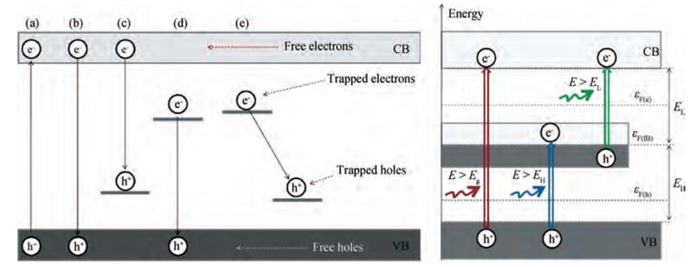
 DownLoad:
DownLoad:
